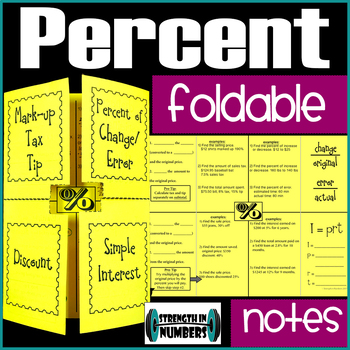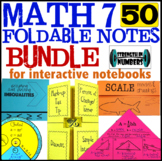PERCENT Change Error Markup Discount Tax Interest Foldable
Strength in Numbers
945 Followers
Grade Levels
6th - 8th
Subjects
Resource Type
Standards
CCSS7.RP.A.2
CCSS7.RP.A.3
CCSSMP1
Formats Included
- PDF
Pages
4 pages
Strength in Numbers
945 Followers
What educators are saying
Great resource! I loved that simple interest, percent error, tax tip discount weren't separated. I think this resource helped my students better see how they were connected.
Also included in
- This bundle includes 3 products for Percent. You will receive foldable notes suitable for interactive notebooks that include percent change, error, mark-up, dicount, tax, tip, and simple interest, a coloring activity, and a practice page with a goformative.com link to use as self-graded practice orPrice $6.00Original Price $8.00Save $2.00
- This bundle includes all of our 7th grade math (pre-algebra) foldables that can be used on their own or in interactive notebooks (INB). This is all you will need to create a beautiful notebook that your students can save and use for reference year after year. Save over 35% when you buy them as a sPrice $75.00Original Price $139.00Save $64.00
Description
Students love foldables for notes! This one has 4 windows for different percent topics - markup, discount, tax, tip, percent of change, percent of error, and simple interest. Fits perfectly in a composition book for interactive notebooks or can be used on its own.
Don't forget to earn TPT credits towards FREE products when you leave feedback! :)
Check out my other PAPER CHAINS:
Easter Peeps – Order of Operations
St. Patrick’s Day – One Step Equations
Measures of Center and Box Plots
Valentine’s Day – Exponent Rules
Check out my other MATH PUZZLES:
Easter – Fractions, Decimals, Percents
Easter – Add and Subtract Integers
Summer – Fractions, Decimals, Percents
Total Pages
4 pages
Answer Key
Included
Teaching Duration
90 minutes
Report this resource to TPT
Reported resources will be reviewed by our team. Report this resource to let us know if this resource violates TPT’s content guidelines.
Standards
to see state-specific standards (only available in the US).
CCSS7.RP.A.2
Recognize and represent proportional relationships between quantities.
CCSS7.RP.A.3
Use proportional relationships to solve multistep ratio and percent problems. Examples: simple interest, tax, markups and markdowns, gratuities and commissions, fees, percent increase and decrease, percent error.
CCSSMP1
Make sense of problems and persevere in solving them. Mathematically proficient students start by explaining to themselves the meaning of a problem and looking for entry points to its solution. They analyze givens, constraints, relationships, and goals. They make conjectures about the form and meaning of the solution and plan a solution pathway rather than simply jumping into a solution attempt. They consider analogous problems, and try special cases and simpler forms of the original problem in order to gain insight into its solution. They monitor and evaluate their progress and change course if necessary. Older students might, depending on the context of the problem, transform algebraic expressions or change the viewing window on their graphing calculator to get the information they need. Mathematically proficient students can explain correspondences between equations, verbal descriptions, tables, and graphs or draw diagrams of important features and relationships, graph data, and search for regularity or trends. Younger students might rely on using concrete objects or pictures to help conceptualize and solve a problem. Mathematically proficient students check their answers to problems using a different method, and they continually ask themselves, "Does this make sense?" They can understand the approaches of others to solving complex problems and identify correspondences between different approaches.




